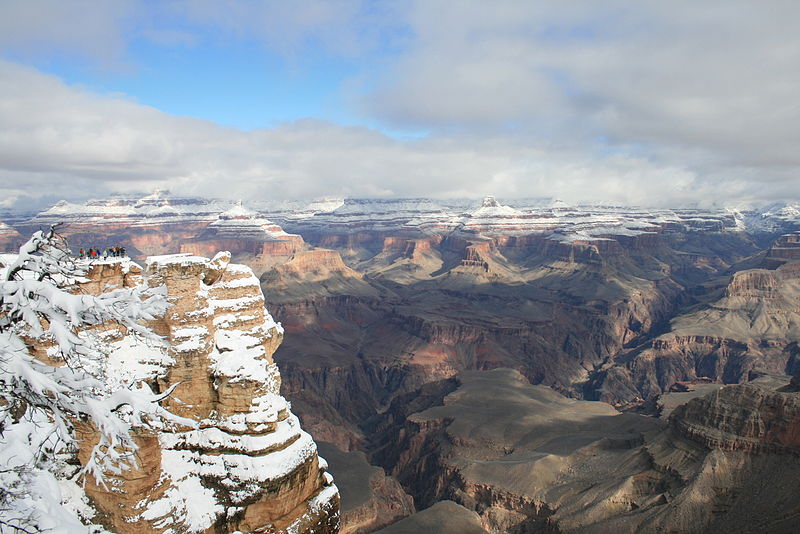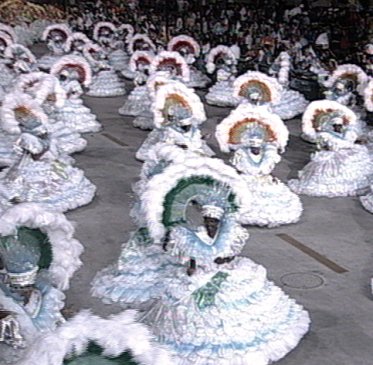 The Grand Canyon is a steep-sided gorge carved by the Colorado River in the United States in the state of Arizona. It is largely contained within the Grand Canyon National Park — one of the first national parks in the United States. President Theodore Roosevelt was a major proponent of preservation of the Grand Canyon area, and visited it on numerous occasions to hunt and enjoy the scenery. View from Grandview Point. A map of the Grand Canyon and surrounding areas, circa 1908.
The Grand Canyon is a steep-sided gorge carved by the Colorado River in the United States in the state of Arizona. It is largely contained within the Grand Canyon National Park — one of the first national parks in the United States. President Theodore Roosevelt was a major proponent of preservation of the Grand Canyon area, and visited it on numerous occasions to hunt and enjoy the scenery. View from Grandview Point. A map of the Grand Canyon and surrounding areas, circa 1908.
Longstanding scientific consensus has been that the canyon was created by the Colorado River over a six million year period. The canyon is 277 miles (446 km) long, ranges in width from 4 to 18 miles (6.4 to 29 km) and attains a depth of over a mile (1.83 km) (6000 feet). Nearly two billion years of the Earth's geological history have been exposed as the Colorado River and its tributaries cut their channels through layer after layer of rock while the Colorado Plateau was uplifted. The "canyon began in the west, followed by another that formed in the east. Eventually, the two broke through and met as a single majestic rent in the earth some six million years ago. The merger apparently occurred where the river today bends to the west, in the area known as the Kaibab Arch."
Before European immigration, the area was inhabited by Native Americans who built settlements within the canyon and its many caves. The Pueblo people considered the Grand Canyon ("Ongtupqa" in Hopi language) a holy site and made pilgrimages to it. The first European known to have viewed the Grand Canyon was García López de Cárdenas from Spain, who arrived in 1540.
Get in Grand Canyon area map
Grand Canyon area map
By carThe majority of visitors to the South Rim of the park arrive from the south on Arizona Route 64 (AZ 64) (conjoined with US highway 180). Alternately, one can enter the south rim from the east on AZ64.
For the south entrance: from Flagstaff, you can take US Route 180 (US 180) northwest to Valle where it joins with AZ 64, and continue north to the south rim; or take I-40 west toward Williams to the junction with AZ 64 and continue north to the south rim. Both routes are approximately 80 miles (129 km). The approx 60 miles (97 km) on US 180 is a narrow 2-lane mountain road through a heavily forested area. The I-40 west is a wide multi-lane interstate for approx 20 miles (32 km), to AZ 64 which is a slightly wider, less mountainous 2-lane highway, and the recommended route during winter weather. There are two lanes at this entrance reserved for pass and prepaid entrance fees (now lanes 1 and 4), which can be pre-purchased outside of the park at the National Geographic Theater/Visitor Center.
 For the east entrance, take US 89 south from Page, AZ or north from Flagstaff to the junction with AZ 64 at Cameron. It is approx 25 miles (40 km) from the junction to the east entrance of the park, and approx 25 miles (40 km) from the east entrance to the south rim village area.Visitors to the North Rim use ALT US 89 to AZ 67 (closed in winter).By plane
For the east entrance, take US 89 south from Page, AZ or north from Flagstaff to the junction with AZ 64 at Cameron. It is approx 25 miles (40 km) from the junction to the east entrance of the park, and approx 25 miles (40 km) from the east entrance to the south rim village area.Visitors to the North Rim use ALT US 89 to AZ 67 (closed in winter).By planeMany Grand Canyon visitors fly into one of two metropolitan airports located within half a day's drive of the South Rim: Las Vegas McCarran International Airport (LAS), which is 275 miles from the South Rim or Phoenix Sky Harbor Airport (PHX), 230 miles from the South Rim.
Flagstaff's Pulliam Field (FLG) is the nearest commercial airport to the canyon. Two daily flights from Los Angeles (LAX) are offered by Horizon Air, and US Airways operates five daily flights from Phoenix. Commuter flights are also available from Phoenix to Page-Lake Powell, Arizona (PGA) on Great Lakes Air, 145 miles Northeast of the park .
Grand Canyon National Park Airport (GCN) is located just outside of the South Rim entrance in the town of Tusayan. It is primarily utilized by companies who provide Grand Canyon air tours and private aircraft. Scheduled air service from Las Vegas to the Grand Canyon is offered by Scenic Airlines, departing out of the Boulder City Municipal Airport (61B). Private charter service is available from other cities. Generally, though, visitors fly commercial airlines into the larger airports in Flagstaff, Phoenix, or Las Vegas.
By busOpen Road Tours, 877-226-8060. runs a daily shuttle service to the South Rim from Flagstaff.
There are currently no bus lines offering transportation to either rim. However, several commercial tour companies offer guided tours originating in Flagstaff, Phoenix, Las Vegas, Los Angeles and other locations, either directly to the South Rim or that include the South Rim as part of an itinerary, and a few offer tours which include a visit to the North Rim.
By guided tourA number of companies provide guided tours of the Canyon that include transportation from the surrounding areas. Some companies will provide bus travel from nearby towns while others begin in the park. Some will provide just a brief tour with small stops, while others may take you on a hike, and arrange all your meals.
By trainThe Grand Canyon Railway operates a train ride from the town of Williams to the Grand Canyon Village (travel time is 2.5 hours in each direction). The terminus at Grand Canyon Village is within walking distance of some accommodations. The train features an historic steam locomotive during the summer season, restored Pullman cars, and a staged old west style shootout. However, the Grand Canyon is not visible from the train. It is simply another option for traveling to the canyon, and takes about twice as long as driving to the canyon.
Amtrak's Southwest Chief, with trains operating daily between Chicago and Los Angeles, stops at Williams Junction, with connections to the Grand Canyon Railway.
Fees/PermitsAll private vehicles entering the Grand Canyon must pay a $25 entrance fee, which is good for seven days. Individuals on foot or on a bike must pay a $12 entrance fee, also good for seven days. Exceptions: those holding an Annual Pass ($80, good for one year), Senior Pass ($10, good for life, available to US citizens 62 and older) or an Access Pass (free, available only to citizens or permanent residents of the United States who are medically determined to be blind or permanently disabled). Note: An Access Pass can only be obtained in person by showing proof of medically determined permanent disability, or eligibility for receiving benefits under federal law.
Get aroundSome of the view points are reachable by car, park service shuttle, motorcoach tour or on foot.
You can go into the canyon by horse, by mule (through guided tours on the south rim from Xanterra, on foot or by boat.
Private stock users (equines only) are required to follow a number of rules and restrictions while in the park, and must get a permit from the park service for overnight use. See Private Stock Use on the park service website for specifics.
From March through November the West Rim Drive is not accessible to most private vehicles (handicap vehicles may request a variance at the entry gate). The park service runs a shuttle during this time. The shuttles are frequent, but long lines form during the busy summer months.
Trans Canyon Shuttle an independent shuttle service runs between the North and the South Rim (No website, Tel 1.928.638.2820).
 The Grand Canyon is a steep-sided gorge carved by the Colorado River in the United States in the state of Arizona. It is largely contained within the Grand Canyon National Park — one of the first national parks in the United States. President Theodore Roosevelt was a major proponent of preservation of the Grand Canyon area, and visited it on numerous occasions to hunt and enjoy the scenery. View from Grandview Point. A map of the Grand Canyon and surrounding areas, circa 1908.
The Grand Canyon is a steep-sided gorge carved by the Colorado River in the United States in the state of Arizona. It is largely contained within the Grand Canyon National Park — one of the first national parks in the United States. President Theodore Roosevelt was a major proponent of preservation of the Grand Canyon area, and visited it on numerous occasions to hunt and enjoy the scenery. View from Grandview Point. A map of the Grand Canyon and surrounding areas, circa 1908.

 For the east entrance, take US 89 south from Page, AZ or north from Flagstaff to the junction with AZ 64 at Cameron. It is approx 25 miles (40 km) from the junction to the east entrance of the park, and approx 25 miles (40 km) from the east entrance to the south rim village area.
For the east entrance, take US 89 south from Page, AZ or north from Flagstaff to the junction with AZ 64 at Cameron. It is approx 25 miles (40 km) from the junction to the east entrance of the park, and approx 25 miles (40 km) from the east entrance to the south rim village area.























